Exploring Spatiotemporal Patterns of Long-Distance Taxi Rides in Shanghai
Abstract
:1. Introduction
2. Data Extraction of Long Distance Taxi Rides
2.1. General FCD Data Description
2.2. Definition of Long-Distance Taxi Rides in Shanghai
2.3. General Information on Long Distance Taxi Rides in Shanghai
3. Spatiotemporal Patterns of Long-Distance Taxi Rides in Shanghai
3.1. Spatial Patterns of Long-Distance Taxi Rides
3.1.1. Identifying Pick-Up Hotspots for Long-Distance Taxi Rides
3.1.2. Identifying Long-Distance Taxi Ride Drop-Off Hotspots
3.1.3. Portion of Long-Distance Taxi Driving
3.2. Temporal Patterns of Long-Distance Taxi Rides
3.2.1. Departure Time Patterns between Workdays and Non-Workdays for Long-Distance Taxi Rides
3.2.2. Difference in Workday and Non-Workday Hotspots for Long-Distance Taxi Rides
3.2.3. Departure Time Patterns for Long Distance Travel Hotspots
3.2.4. Travel Distance Patterns for Long-Distance Hotspots
3.3. Interrelations Among the Long-Distance Pick-Up and Drop-Off Hotspots
4. Conclusions
Acknowledgments
Author Contributions
Conflicts of Interest
References
- Huber, W.; Lädke, M.; Ogger, R. Extended floating-car data for the acquisition of traffic information. In Proceedings of the 6th World Congress on Intelligent Transport Systems, Toronto, ON, Canada, 8–12 November 1999. [Google Scholar]
- Liu, Y.; Kang, C.; Gao, S.; Xiao, Y.; Tian, Y. Understanding intra-urban trip patterns from taxi trajectory data. J. Geogr. Syst. 2012, 14, 463–483. [Google Scholar] [CrossRef]
- Sohr, A.; Brockfeld, E.; Krieg, S. Quality of floating car data. In Proceedings of the WCTR 2010—World Conference on Transport Research, Lisbon, Portugal, 11–15 July 2010. paper nr 02392. [Google Scholar]
- Liu, L.; Andris, C.; Biderman, A.; Ratti, C. Revealing taxi driver’s mobility intelligence through his trace. IEEE Pervasive Comput. 2009, 160, 1–17. [Google Scholar]
- Goldsberry, K. Limitations and potentials of real-time traffic visualization for wayfinding. In Proceedings of the 22nd ICA/ACI International Cartographic Conference, A Coruna, Spain, 9–16 July 2005. [Google Scholar]
- Goldsberry, K. GeoVisualization of automobile congestion. In Proceedings of the AGILE 2008 Conference: GeoVisualization of Dynamics, Movement and Change, Girona, Spain, 5 May 2008. [Google Scholar]
- Veloso, M.; Phithakkitnukoon, S.; Bento, C. Sensing urban mobility with taxi flow. In Proceedings of the International Workshop on Location-Based Social Networks, Chicago, IL, USA, 1–4 November 2011; ACM: New York, NY, USA. [Google Scholar]
- Yuan, Y.; Raubal, M.; Liu, Y. Correlating mobile phone usage and travel behavior—A case study of harbin, china. Comput. Environ. Urban Syst. 2012, 36, 118–130. [Google Scholar] [CrossRef]
- Li, B.; Zhang, D.; Sun, L.; Chen, C.; Li, S.; Qi, G.; Yang, Q. Hunting or waiting? Discovering passenger-finding strategies from a large-scale real-world taxi dataset. In Proceedings of the IEEE International Conference on Pervasive Computing and Communications Workshops, Seattle, WA, USA, 21–25 March 2011. [Google Scholar]
- Zhan, X.; Hasan, S.; Ukkusuri, S.V.; Kamga, C. Urban link travel time estimation using large-scale taxi data with partial information. Transp. Res. Part C 2013, 33, 37–49. [Google Scholar] [CrossRef]
- Ebendt, R.; Sohr, A.; Tcheumadjeu, L.C.T.; Wagner, P. Dynamische Neuplanung der Touren von Express Trucks unter Einbeziehung einer FCD-basierten Verkehrslage. In Proceedings of the Multikonferenz Der Wirtschaftsinformatik, Goettingen, Germany, 23–25 February 2010; pp. 125–136. [Google Scholar]
- Powell, J.W.; Huang, Y.; Bastani, F.; Ji, M. Towards reducing taxicab cruising time using spatio-temporal profitability maps. In International Conference on Advances in Spatial and Temporal Databases; Springer: Berlin, Germany, 2011; Volume 6849, pp. 242–260. [Google Scholar]
- Zheng, Y.; Zhou, X. Computing with Spatial Trajectories; Springer: Berlin, Germany, 2011; ISBN 978-1-4614-1628-9. [Google Scholar]
- Guo, H.; Wang, Z.; Yu, B.; Zhao, H.; Yuan, X. TripVista: Triple Perspective Visual Trajectory Analytics and Its Application on Microscopic Traffic Da-ta at a Road Intersection. In Proceedings of the IEEE Pacific Visualization Symposium (PacificVis 2011), Hong Kong, China, 1–4 March 2011; IEEE Computer Society: Washington, DC, USA; pp. 163–170. [Google Scholar]
- Tominski, C.; Schumann, H.; Andrienko, G.; Andrienko, N. Stacking-based visualization of trajectory attribute data. IEEE Trans. Vis. Comput. Graph. 2012, 18, 2565–2574. [Google Scholar] [CrossRef] [PubMed]
- Andrienko, G.; Andrienko, N.; Bak, P.; Keim, D.; Kisilevich, S.; Wrobel, S. A conceptual framework and taxonomy of techniques for analyzing movement. J. Vis. Lang. Comput. 2011, 22, 213–232. [Google Scholar] [CrossRef]
- Andrienko, N.; Andrienko, G. Visual analytics of movement: An overview of methods, tools and procedures. Inf. Vis. 2013, 12, 3–24. [Google Scholar] [CrossRef]
- Shen, J.; Liu, X.; Chen, M. Discovering spatial and temporal patterns from taxi-based Floating Car Data: A case study from Nanjing. GIScience Remote Sens. 2017, 54, 617–638. [Google Scholar] [CrossRef]
- Chang, H.W.; Tai, Y.C.; Chen, H.W.; Yung, J.; Hsu, J. Itaxi: Context-aware taxi demand hotspots prediction using ontology and data mining approaches. In Proceedings of the 13th Conference on Artificial Intelligence and Applications (TAAI 2008), Varna, Bulgaria, 4–6 September 2008. [Google Scholar]
- Li, X.; Pan, G.; Wu, Z.; Qi, G.; Li, S.; Zhang, D.; Zhang, W. Prediction of urban human mobility using large-scale taxi traces and its applications. Front. Comput. Sci. 2012, 6, 111–121. [Google Scholar]
- Ding, L.; Fan, H.; Meng, L. Understanding taxi driving behaviors from movement data. In AGILE 2015; Lecture Notes in Geoinformation and Cartography; Bacao, F., Santos, M.Y., Painho, M., Eds.; Springer: Berlin, Germany, 2015. [Google Scholar]
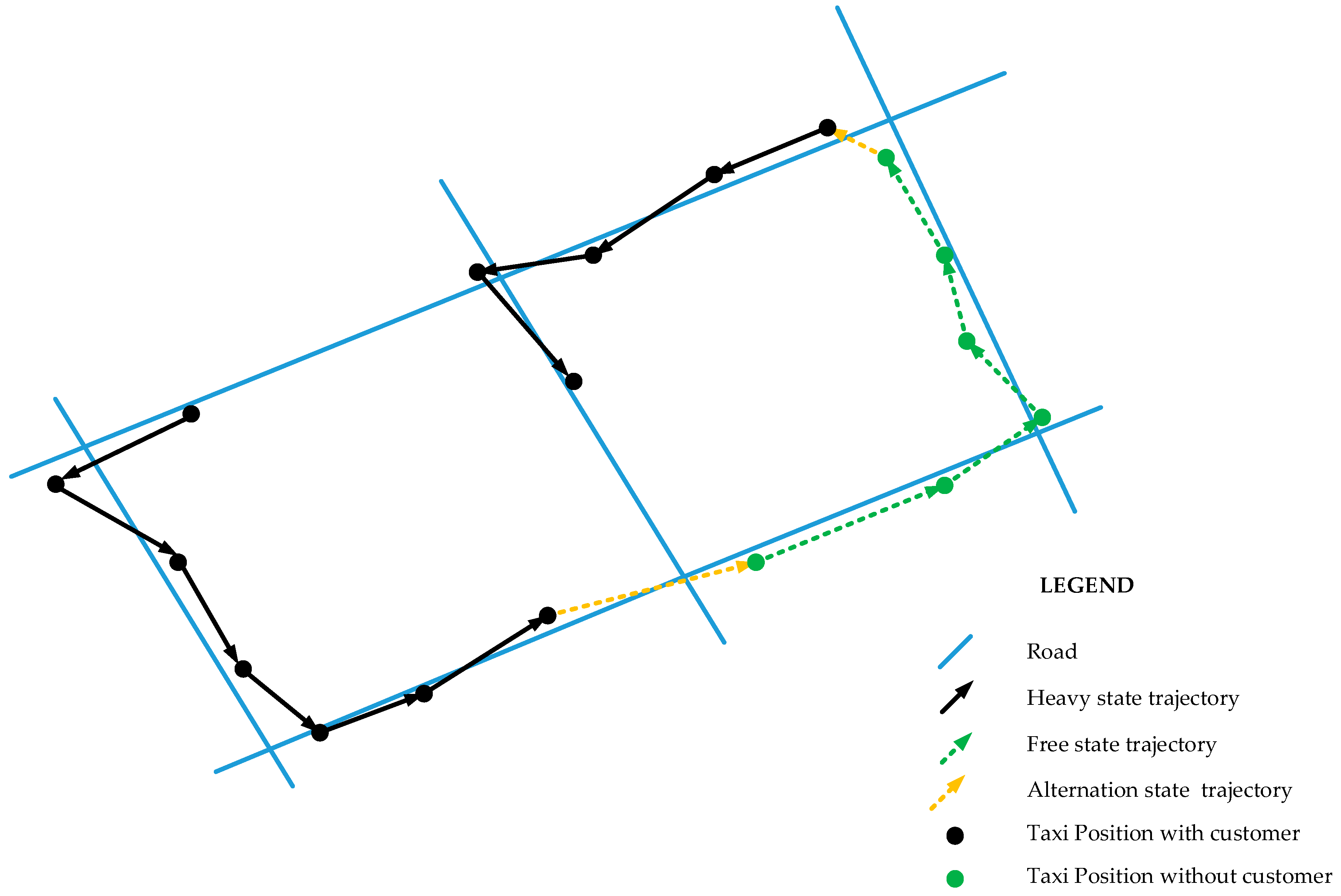
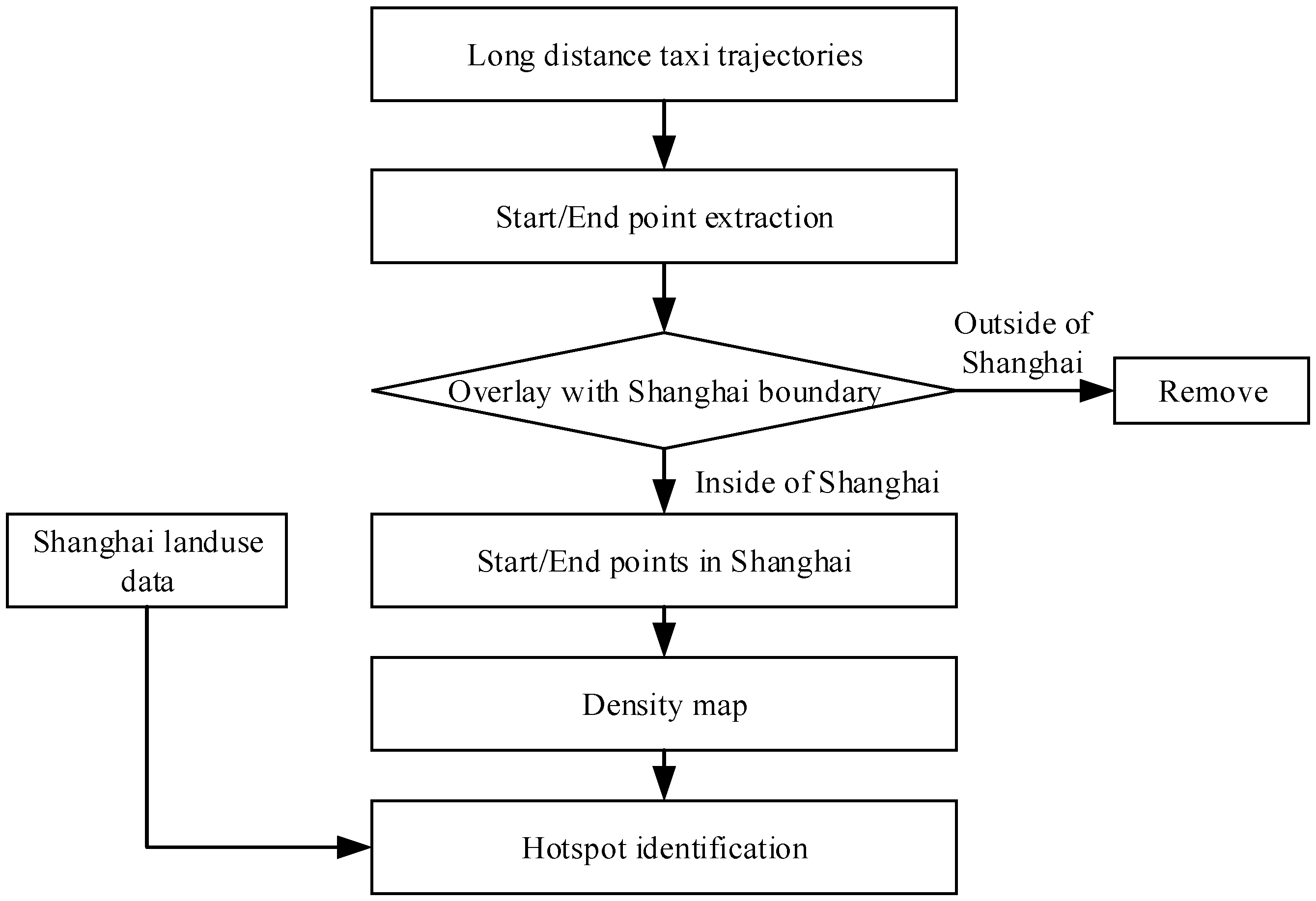
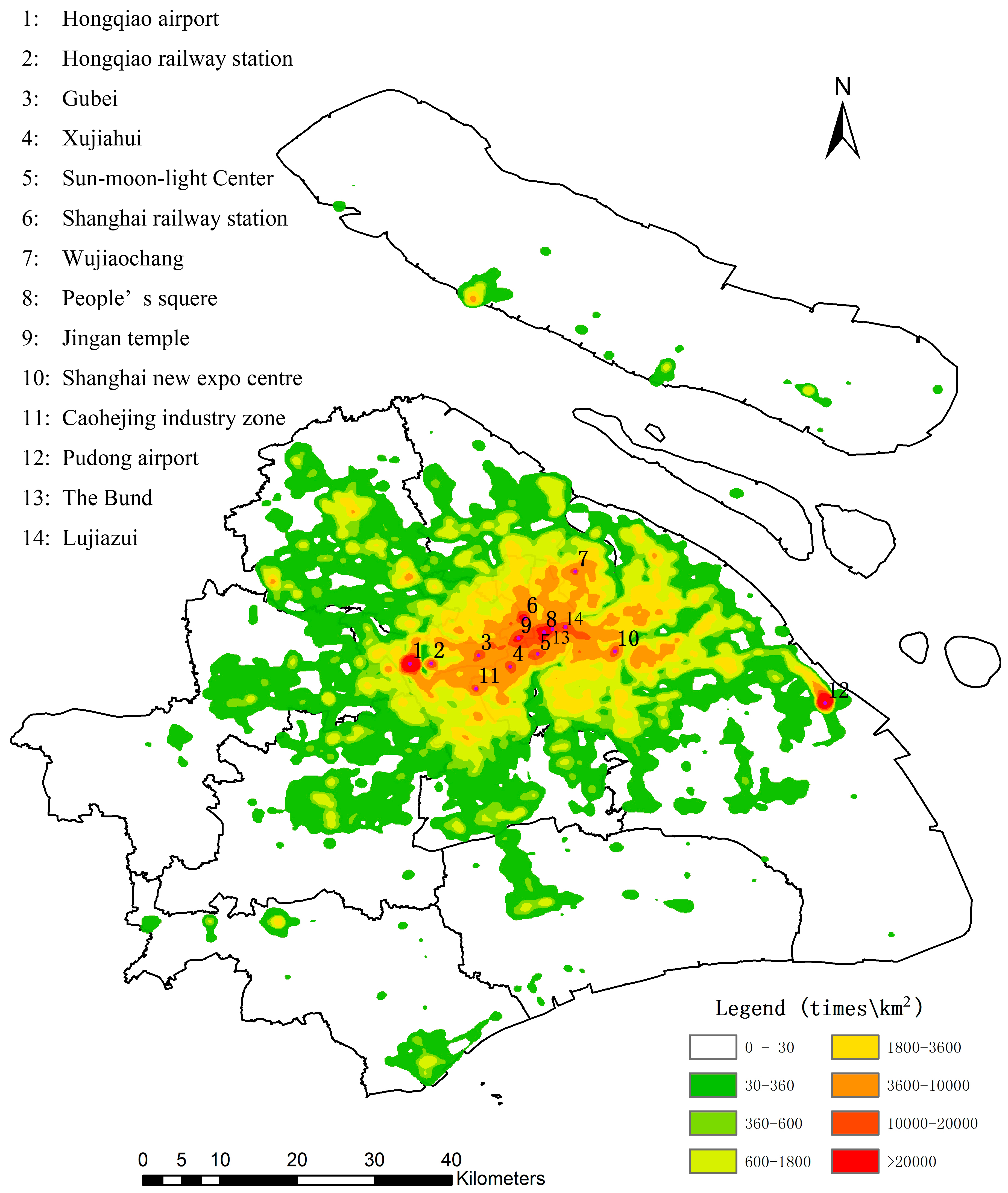
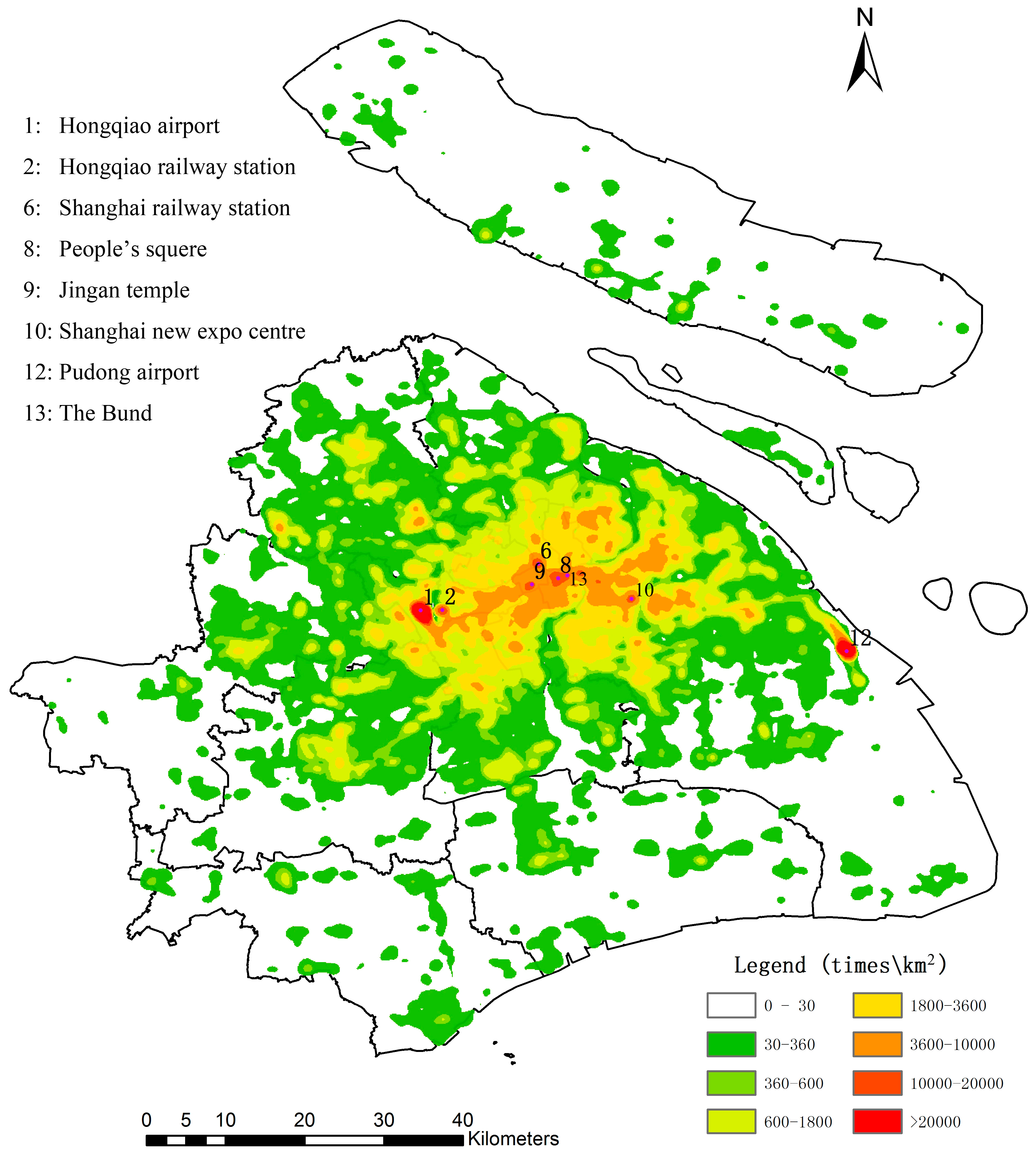

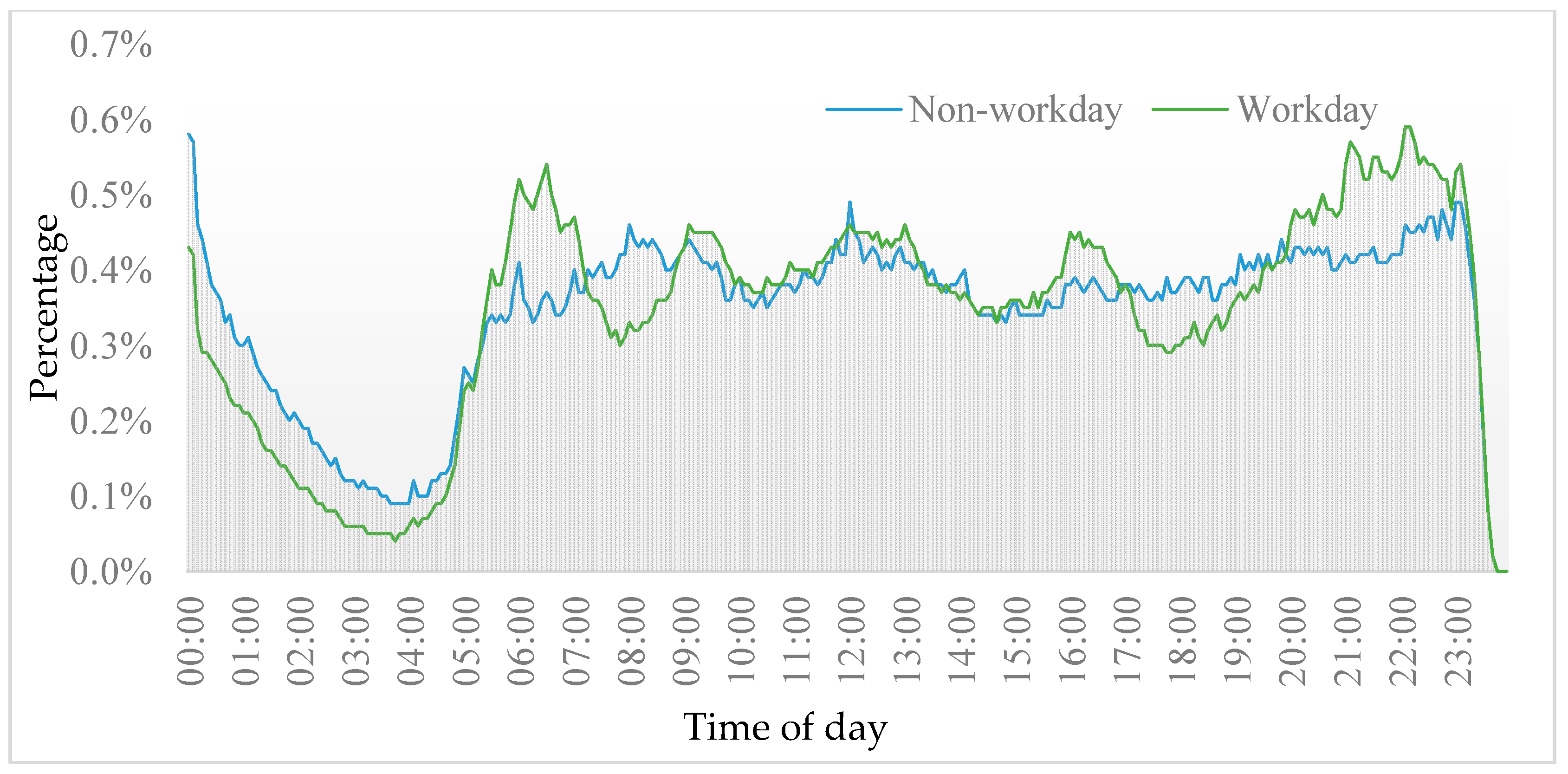
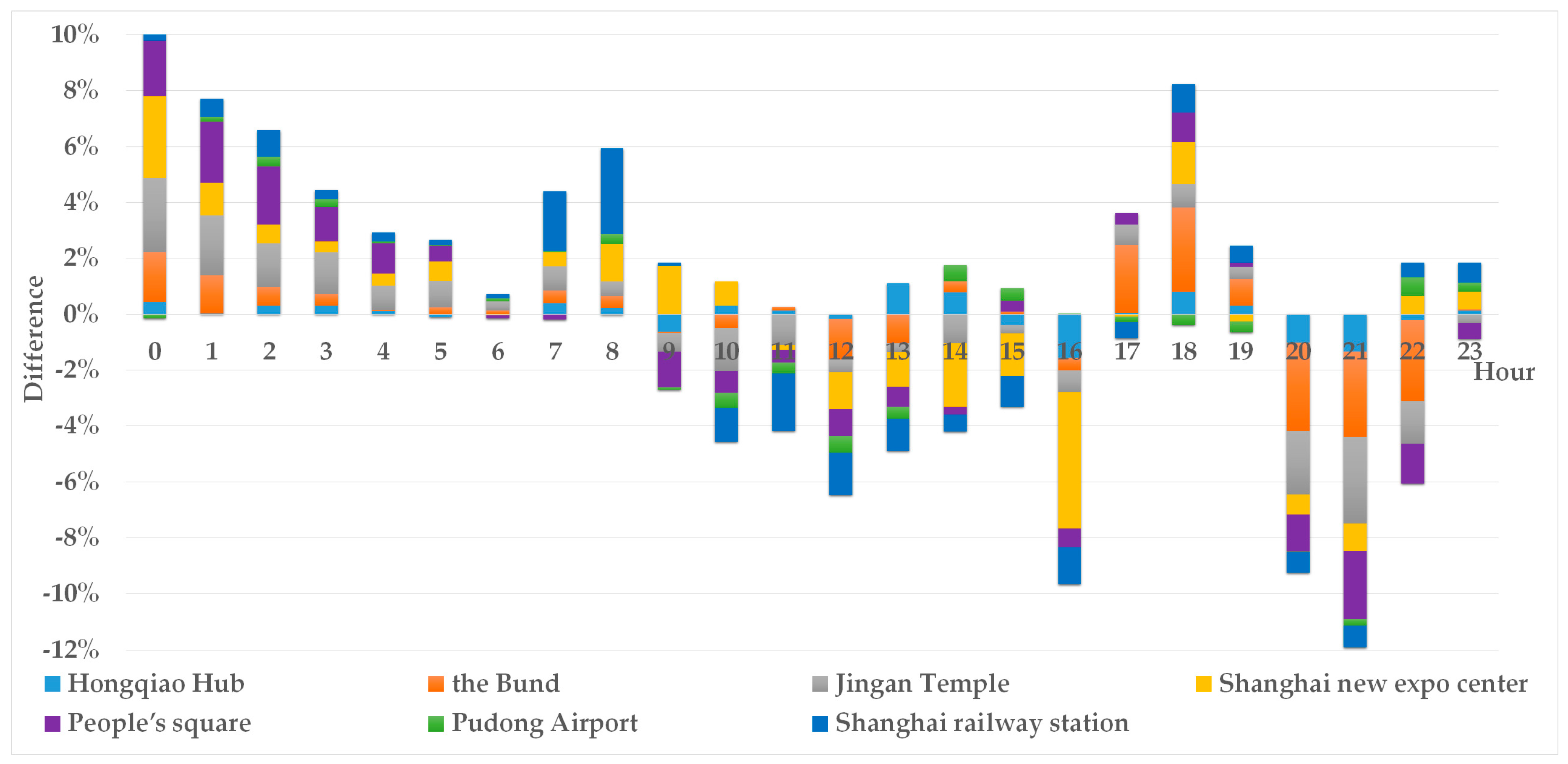
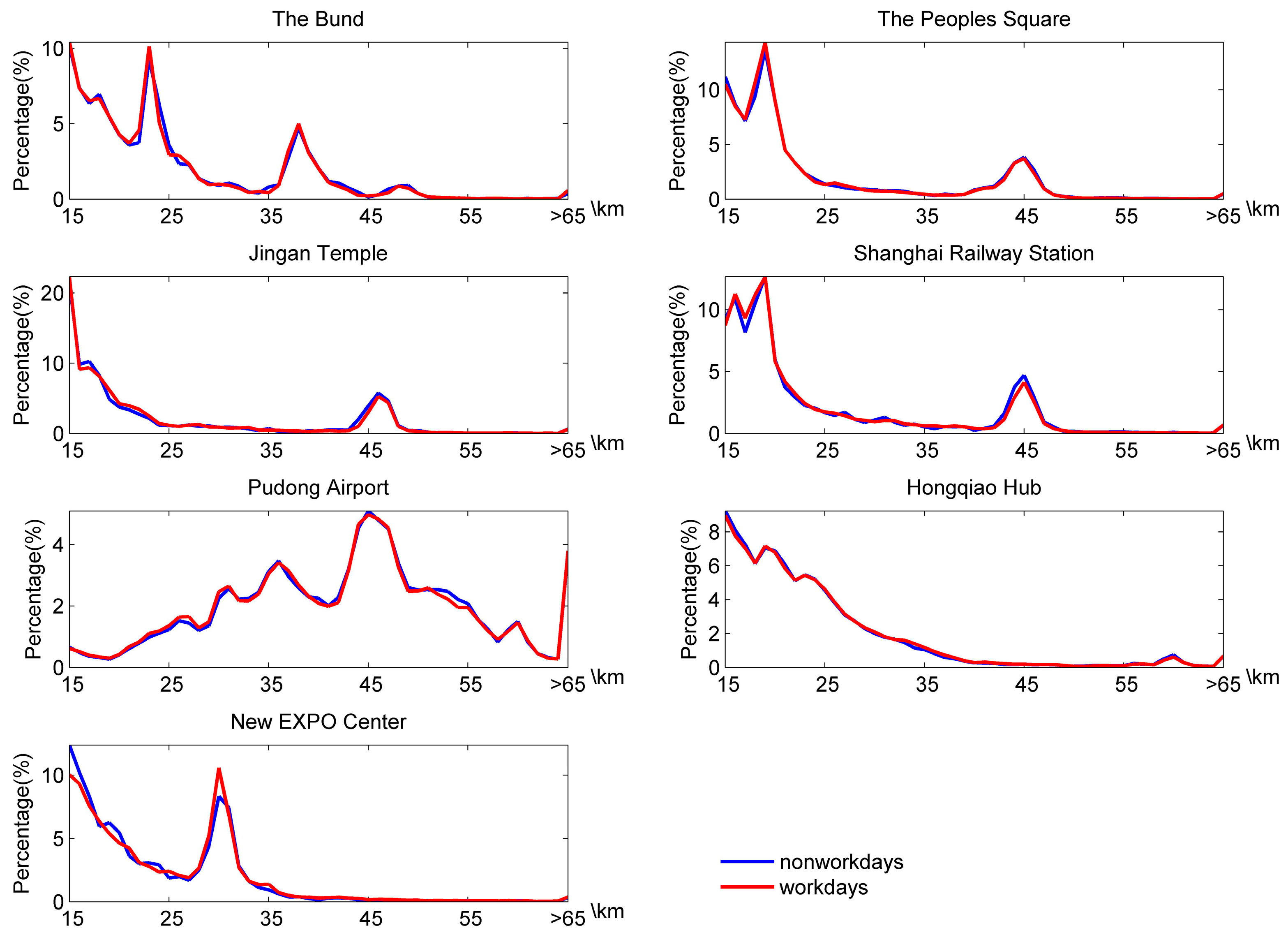
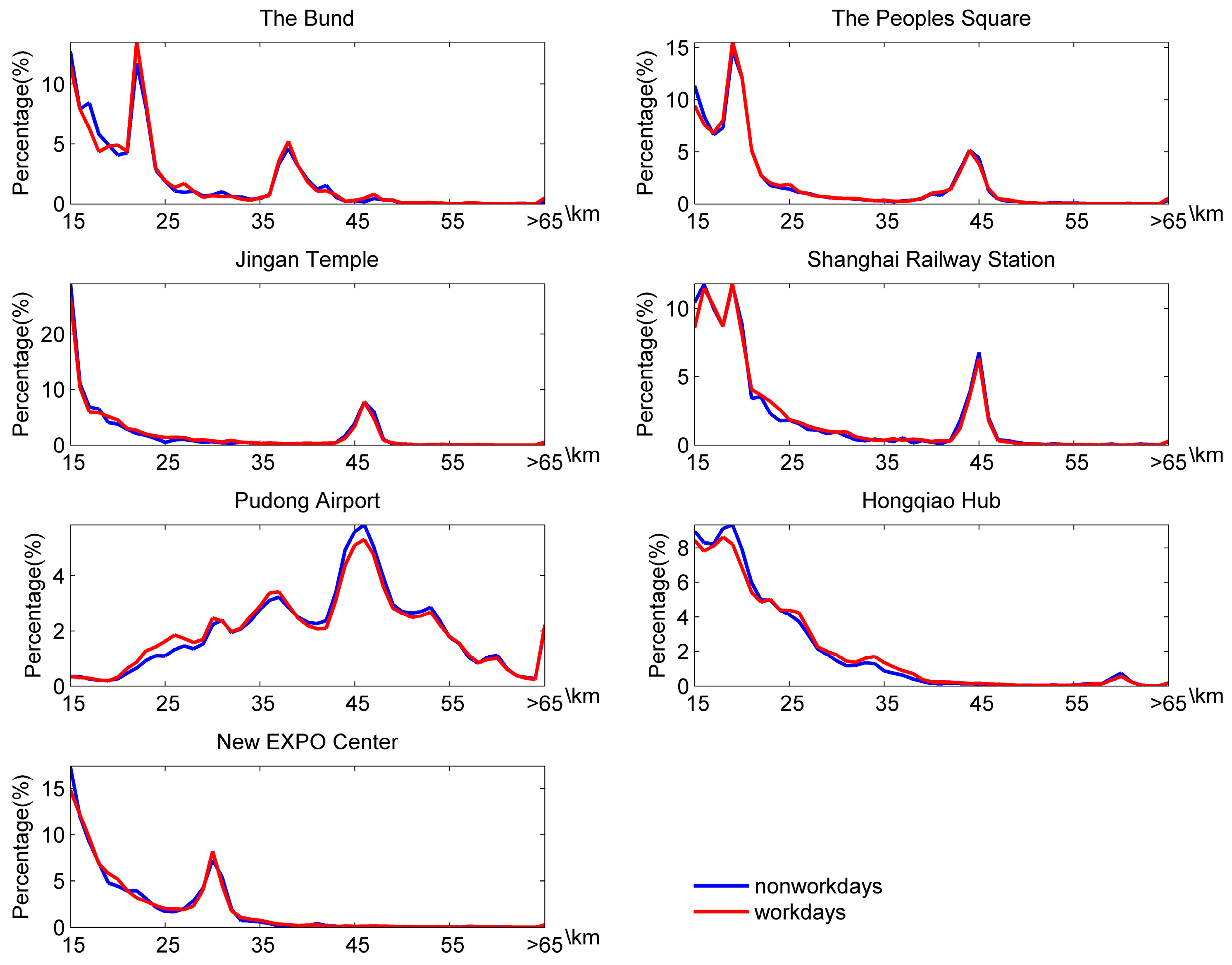
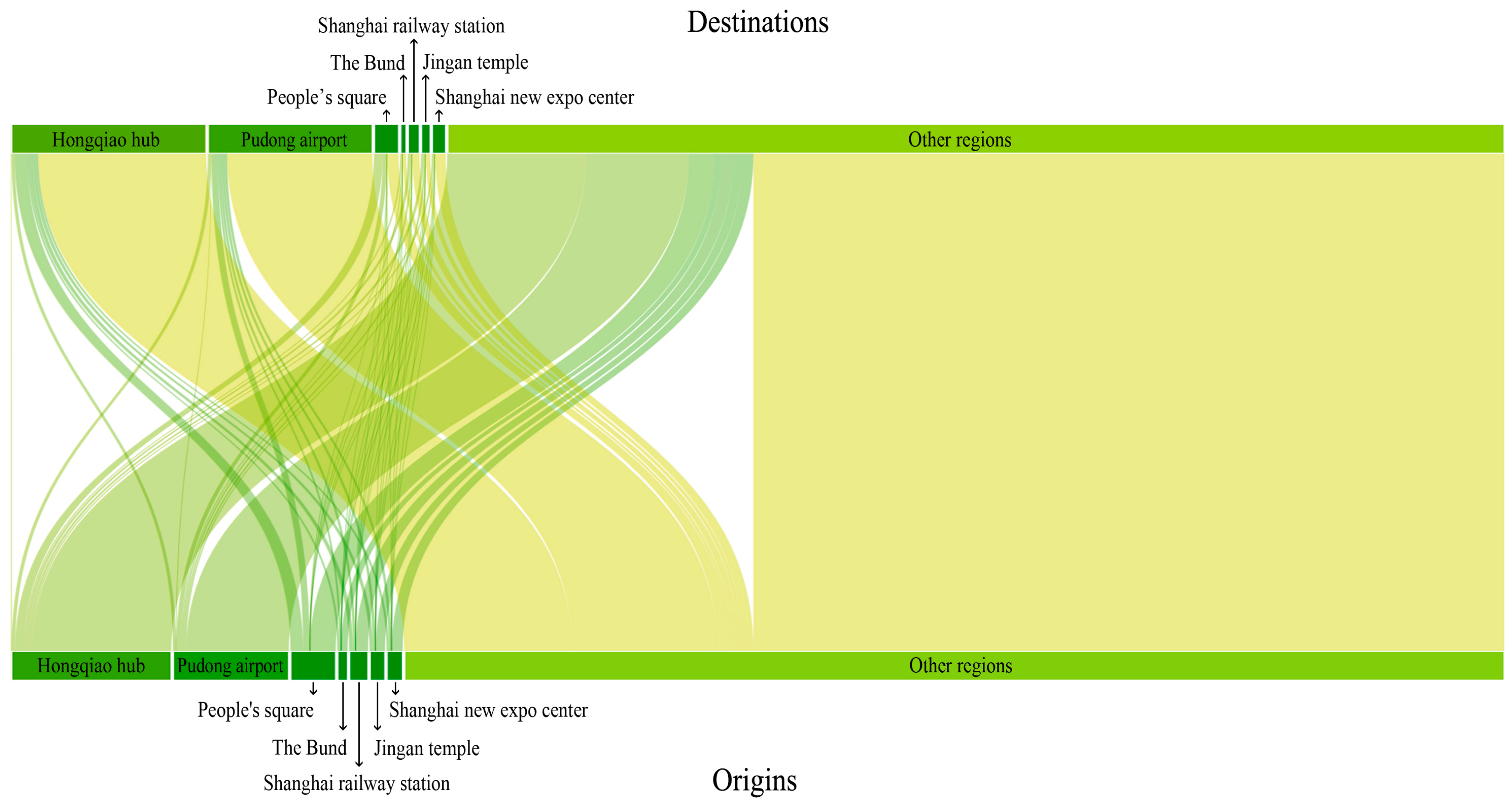
| Time | Distance (D) | Sf | SDf | LDf | WFf |
|---|---|---|---|---|---|
| 5:00 a.m.–11:00 p.m. | <15 km | 14 | (D−3) × 2.5 | 0 | T/4 × 2.5 |
| >15 km | 14 | (15−3) × 2.5 | (D−15) × 3.6 | T/4 × 2.5 | |
| 11:00 p.m.–12:00 a.m. 12:00 a.m.–5:00 a.m. | <15 km | 17 | (D−3) × 3.6 | 0 | T/4 × 3.6 |
| >15 km | 17 | (15−3) × 3.6 | (D−15) × 4.7 | T/4 × 3.6 |
| Index | Long Distance Trips | Short Distance Trips | |
|---|---|---|---|
| Travel Mileage | Value (km) | 6.2910 | 4.4910 |
| Percentage | 58.35% | 41.65% | |
| Travel Time | Value (hours) | 3,061,564 | 9,533,246 |
| Percentage | 24.30% | 75.70% | |
| Average Distance Traveled | Value (km) | 20.5 | 4.7 |
| Hotspot Type | Number | Name |
|---|---|---|
| Transportation | 12 | Pudong airport |
| 1,2 | Hongqiao hub | |
| 6 | Shanghai railway station | |
| Exhibition | 10 | Shanghai new expo center |
| Tourism | 8 | People’s square |
| 9 | Jingan temple | |
| 13 | The Bund |
| ID | Name | Type | T | LD | P | LDW | LDNW | R |
|---|---|---|---|---|---|---|---|---|
| 12 | Pudong airport | Departure | 197,298 | 184,894 | 93.71% | 141,514 | 52,259 | 2.70 |
| Arrival | 268,846 | 259,584 | 96.55% | 191,207 | 68,377 | 2.79 | ||
| 1,2 | Hongqiao hub | Departure | 461,086 | 325,220 | 70.53% | 240,336 | 84,884 | 2.83 |
| Arrival | 634,653 | 300,146 | 47.29% | 230,484 | 69,662 | 3.30 | ||
| 6 | Shanghai railway Station | Departure | 151,421 | 28,922 | 19.10% | 21,008 | 7914 | 2.65 |
| Arrival | 68,449 | 17,626 | 25.75% | 13,078 | 4548 | 2.88 | ||
| 10 | Shanghai new expo centre | Departure | 139,885 | 26,328 | 18.82% | 20,971 | 5357 | 3.91 |
| Arrival | 87,139 | 22,213 | 25.49% | 17,912 | 4211 | 4.25 | ||
| 8 | People’s square | Departure | 420,873 | 69,689 | 16.55% | 49,954 | 19,735 | 2.53 |
| Arrival | 176,279 | 39,462 | 22.38% | 28,968 | 10,684 | 2.71 | ||
| 9 | Jingan temple | Departure | 150,111 | 23,630 | 15.74% | 17,895 | 5735 | 3.12 |
| Arrival | 70,221 | 14,450 | 20.57% | 10,753 | 3697 | 4.61 | ||
| 14 | The Bund | Departure | 81,539 | 16,281 | 19.96% | 12,547 | 3734 | 3.36 |
| Arrival | 47,299 | 9084 | 19.20% | 6807 | 2277 | 2.98 |
| Hotspot | Peak Distance (km) | Target at Peak Distance |
|---|---|---|
| The Bund | 37–41 | Pudong airport |
| Jingan temple | 44–48 | Pudong airport |
| Shanghai new expo center | 28–32 | Pudong airport, Hongqiao hub |
| People’s square | 42–46 | Pudong airport |
| Shanghai railway station | 44–47 | Pudong airport |
| Region | Origin | ||
|---|---|---|---|
| Hotspots | Other Regions | ||
| Destination | Hotspots | 154,624 (5.05%) | 632,963 (20.67%) |
| Other Regions | 374,625 (23.57%) | 1,552,071 (50.69%) | |
© 2017 by the authors. Licensee MDPI, Basel, Switzerland. This article is an open access article distributed under the terms and conditions of the Creative Commons Attribution (CC BY) license (http://creativecommons.org/licenses/by/4.0/).
Share and Cite
Wu, H.; Fan, H.; Wu, S. Exploring Spatiotemporal Patterns of Long-Distance Taxi Rides in Shanghai. ISPRS Int. J. Geo-Inf. 2017, 6, 339. https://doi.org/10.3390/ijgi6110339
Wu H, Fan H, Wu S. Exploring Spatiotemporal Patterns of Long-Distance Taxi Rides in Shanghai. ISPRS International Journal of Geo-Information. 2017; 6(11):339. https://doi.org/10.3390/ijgi6110339
Chicago/Turabian StyleWu, Hangbin, Hongchao Fan, and Shengyuan Wu. 2017. "Exploring Spatiotemporal Patterns of Long-Distance Taxi Rides in Shanghai" ISPRS International Journal of Geo-Information 6, no. 11: 339. https://doi.org/10.3390/ijgi6110339





